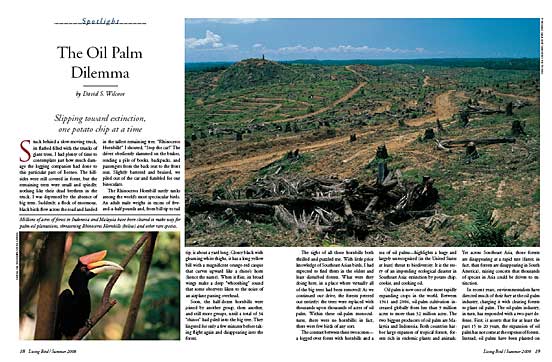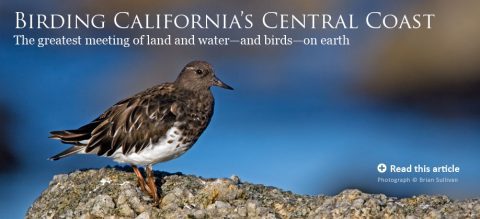Palm Oil, or the Conservation Dilemma of the Potato Chip
By David Wilcove July 15, 2008

Stuck behind a slow-moving truck, its flatbed filled with the trunks of giant trees, I had plenty of time to contemplate just how much damage the logging companies had done to this particular part of Borneo. The hillsides were still covered in forest, but the remaining trees were small and spindly, nothing like their dead brethren in the truck. I was depressed by the absence of big trees. Suddenly, a flock of enormous, black birds flew across the road and landed in the tallest remaining tree. “Rhinoceros Hornbills!” I shouted, “Stop the car!” The driver obediently slammed on the brakes, sending a pile of books, backpacks, and passengers from the back seat to the front seat. Slightly battered and bruised, we piled out of the car and fumbled for our binoculars.
The Rhinoceros Hornbill surely ranks among the world’s most spectacular birds. An adult male weighs in excess of five-and-a-half pounds and, from bill tip to tail tip, is about a yard long. Glossy black with gleaming white thighs, it has a long yellow bill with a magnificent orange-red casque that curves upward like a rhino’s horn (hence the name). When it flies, its broad wings make a deep “whooshing” sound that some observers liken to the noise of an airplane passing overhead.
Soon, the half-dozen hornbills were joined by another group, then another, and still more groups, until a total of 34 “rhinos” had piled into the big tree. They lingered for only a few minutes before taking flight again and disappearing into the forest.
The sight of all those hornbills both thrilled and puzzled me. With little prior knowledge of Southeast Asian birds, I had expected to find them in the oldest and least disturbed forests. What were they doing here, in a place where virtually all of the big trees had been removed? As we continued our drive, the forests petered out entirely; the trees were replaced with thousands upon thousands of acres of oil palm. Within these oil-palm monocultures, there were no hornbills; in fact, there were few birds of any sort.
The contrast between these two scenes—a logged-over forest with hornbills and a sea of oil palms—highlights a huge and largely unrecognized (in the United States at least) threat to biodiversity. It is the story of an impending ecological disaster in Southeast Asia: extinction by potato chip, cookie, and cooking oil.
Oil palm is now one of the most rapidly expanding crops in the world. Between 1961 and 2006, oil-palm cultivation increased globally from less than 9 million acres to more than 32 million acres. The two biggest producers of oil palm are Malaysia and Indonesia. Both countries harbor large expanses of tropical forests, forests rich in endemic plants and animals. Yet across Southeast Asia, those forests are disappearing at a rapid rate (faster, in fact, than forests are disappearing in South America), raising concern that thousands of species in Asia could be driven to extinction.
In recent years, environmentalists have directed much of their fury at the oil-palm industry, charging it with clearing forests to plant oil palm. The oil-palm industry, in turn, has responded with a two-part defense. First, it asserts that for at least the past 15 to 20 years, the expansion of oil palm has not come at the expense of forests. Instead, oil palms have been planted on lands that had previously been converted to rubber plantations, commercial crops, pastures, and other uses. Second, the industry argues that, contrary to the claims of environmentalists, oil-palm plantations are not sterile monocultures; instead, the plantations are actually beneficial for biodiversity, more akin to a “planted forest” than a crop.
Lian Pin Koh, a graduate student at Princeton University, and I decided to take a critical look at both assertions. To determine whether forests are being cleared to make way for oil palm, we examined national land-use data collected by the governments of Malaysia and Indonesia and compiled by the Food and Agriculture Organization (FAO) of the United Nations. The results were striking: between 1990 and 2005, the acreage of rubber, cropland, and pasture in both countries decreased. However, that decrease is far too small to account for the huge expansion of oil palm that has occurred over the same period. In other words, both countries must have cleared millions of acres of forest for oil palm to account for all the land that has been placed under oil-palm cultivation since 1990. Indeed, our analysis indicates that more than half of the oil-palm expansion in Malaysia and Indonesia during this 15-year period had to come from forests.
But which forests? The FAO data also indicate that the amount of primary or virgin forests in Malaysia did not decrease during this period. If so, then the forests that were cleared to make way for oil palm must have been secondary or logged forests, forests not unlike the spot where I saw the Rhinoceros Hornbills. (We lack comparable data for Indonesia).
Of course, if logged forests have little value for biodiversity, then their conversion to oil palm would not be too alarming. This brings us to the second question: What is the biodiversity value of primary and secondary forests compared with oil-palm plantations? Are oil-palm plantations the biological deserts portrayed by many environmentalists, or are they more akin to forests, as the oil-palm growers assert? A flock of hornbills here or there is hardly sufficient evidence to answer this question. To tackle this issue, we compared the abundance of forest-dwelling birds and butterflies in primary forests, secondary forests, and oil-palm plantations. Compared with most other types of animals (such as mammals, beetles, etc.), birds and butterflies are relatively easy to identify and count, making them ideal for this sort of comparison. The bird data were gathered in Peninsular Malaysia and published by ecologist Kelvin Peh and colleagues; the butterfly data were obtained by Keith Hamer, A. J. Dumbrell, Lian Pin Koh, and others in Sabah, Borneo.
Both birds and butterflies showed very similar patterns. The number of forest-dwelling species was lower in the secondary forests than in the primary forests. Clearly, the cutting of the big trees renders the forest unsuitable for some species. However, a far bigger drop in biodiversity occurs when a secondary (logged) forest is converted to an oil-palm plantation. Roughly three-quarters of the remaining forest-dwelling bird and butterfly species disappear. Protection of these disturbed forests is therefore crucial to the survival of Southeast Asia’s beleaguered wildlife. But it won’t be easy.
Oil palm is a highly profitable export crop for Malaysia, Indonesia, and other developing countries. In addition, many of the large plantations provide housing, medical care, education, and other vital benefits to workers and their families. For these reasons, it is unlikely that the governments of the countries in question would be keen to curtail growth of the oil-palm industry. Moreover, palm oil is used throughout Asia as cooking oil. It is also used around the world as an ingredient in countless food items and household products, from potato chips to margarine to dishwashing liquid to lipstick. (Indeed, it is listed as an ingredient in the chocolate-chip cookies I’m eating as I write these words). The fact that palm oil is used in so many ways and in so many places makes it a tough product to avoid. Moreover, with the rise in petroleum prices, interest in using it as a biofuel is growing, a development that could hasten the creation of new plantations.
Pressure from American and European stockholders on companies involved in the oil-palm business may prompt those companies to halt further conversion of forests. And dialogue between the more progressive oil-palm companies and environmental organizations could lead to the development of guidelines for a more sustainable palm-oil industry. The latter, at least, appears to be happening under the aegis of the Roundtable on Sustainable Palm Oil. The roundtable aims to bring together companies, environmental organizations, and other partners in an effort to create a more sustainable future for oil palm. One hopes that forest conservation is at the top of the list of issues they intend to tackle. In the meantime, Southeast Asia’s hornbills and other wildlife are slipping closer to extinction, one potato chip at a time.
Further Reading
Lian Pin Koh and David S. Wilcove. “Is oil palm agriculture really destroying tropical biodiversity?” Conservation Letters, in press (2008).


All About Birds is a free resource
Available for everyone,
funded by donors like you









